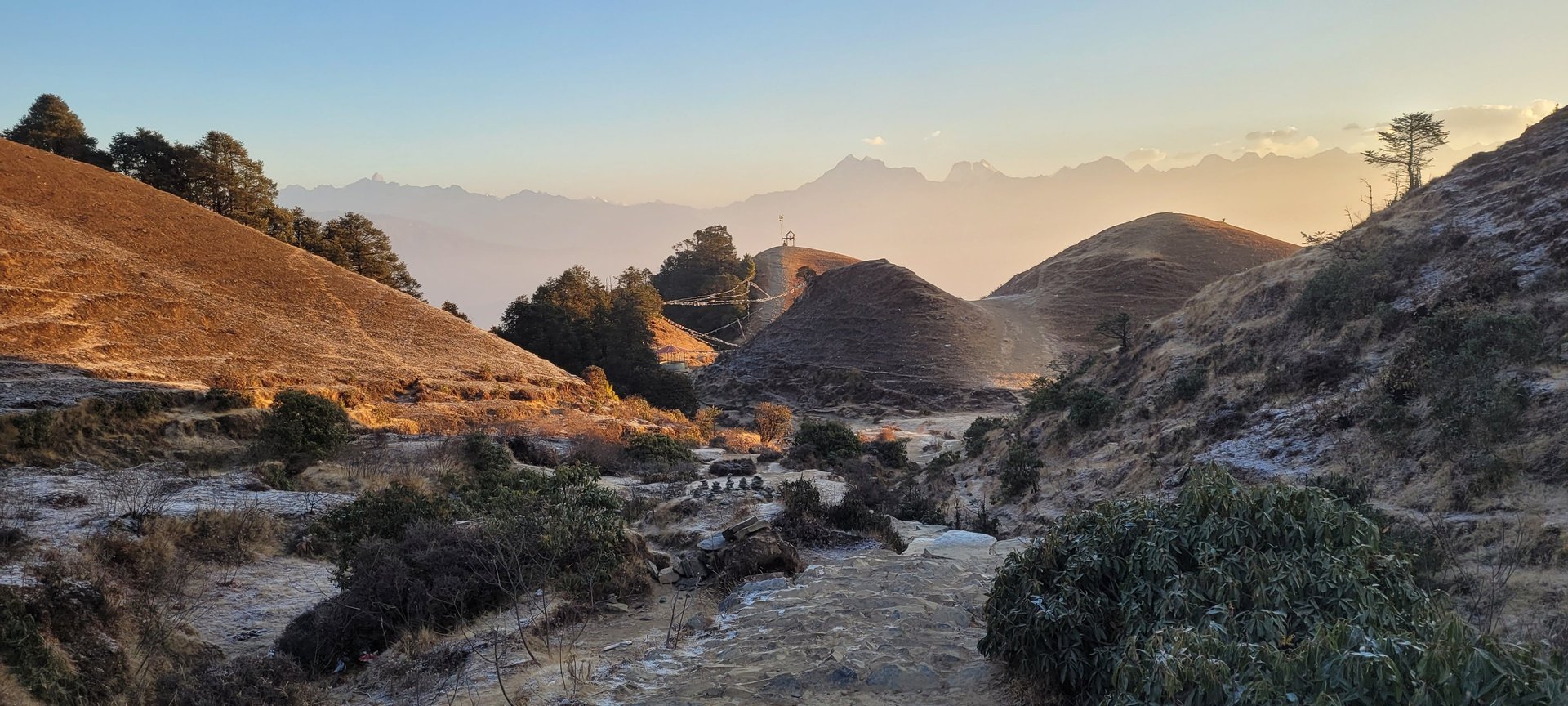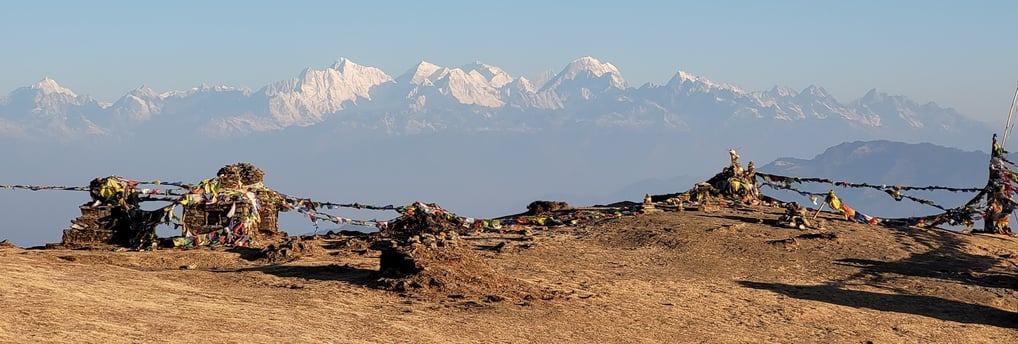

To continue exploring the short hikes near Kathmandu, we decided to celebrate Valentine’s Day in the most us way possible—by hiking Sailung and Kalinchowk. Romantic dinner? Nah. A scenic trek with breathtaking sunrises, ancient temples, and endless rolling hills? Absolutely.
I’ve always been in love with long treks in the Himalayas, but lately, I’ve been obsessed with finding off-the-beaten-path trails—places where history, spirituality, and raw natural beauty come together. my husband, who has been a trekking guide for many years, knows all the hidden gems of Nepal. Seriously, you won’t find this information anywhere else (bold from me, yeah?). And I love sharing these stories with you.
When people come to Nepal, they don’t just want to see mountains—they want to experience culture. And let me tell you, visiting places like Sailung and Kalinchowk will show you more about Nepali traditions, beliefs, and way of life than any crowded trekking route ever could.
So grab a cup of tea, get cozy, and keep reading, my friends—this is going to be a good one!
Why Sailung is Important for Nepali People
Sailung isn’t just a place with rolling green hills and jaw-dropping Himalayan views—it’s a land deeply connected to the spiritual and cultural roots of Nepal. While it remains way off the beaten path for most tourists, for locals, Sailung is a sacred place filled with history, legends, and powerful energy that has drawn pilgrims, monks, and seekers of peace for generations.
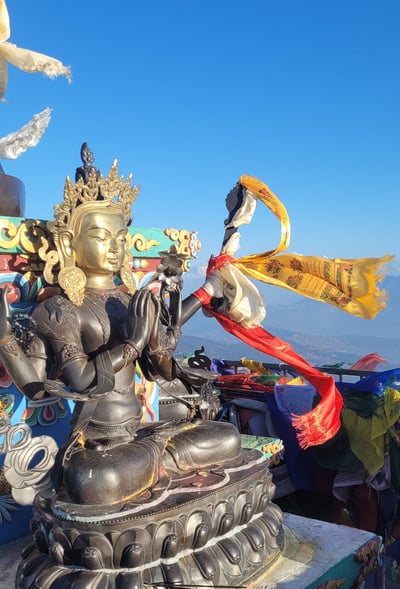

At 3,200 meters, Sailung feels like a gateway between the earth and sky. But this place isn’t just about the altitude—it’s about its divine presence. At the highest point stands the Sailungeshwor Mahadev Temple, dedicated to Lord Shiva. This temple is where Hindu devotees come to pray, meditate, and seek blessings, especially during major festivals like Shivaratri and Janai Purnima.
Legend has it that Sailung was once a vast lake where gods performed sacrifices, and over time, it dried up, leaving behind the 100 hills we see today. Another belief? That great saints once meditated here, and each of the rolling hills represents their presence—hence the name Sailung, meaning "Land of a Hundred Hillocks".
Even today, during the full moon in July, Shamans from all over Nepal gather here to perform ancient rituals, chanting and dancing under the open sky, connecting with spirits and ancestral energies.
And during Shivaratri, this place truly comes alive. Devotees trek up to the Sailungeshwor Mahadev Temple, light fires, and stay awake all night, chanting mantras and performing rituals, waiting for the first light of dawn to offer prayers to Lord Shiva. It’s believed that during this time, the veil between the spiritual and physical world is at its thinnest, and blessings are at their most powerful. Whether you take these legends and rituals literally or simply see them as a window into Nepal’s rich cultural heritage, there’s no denying the otherworldly energy of Sailung.
Buddhists also hold Sailung as sacred. It is believed that Guru Padmasambhava (Guru Rinpoche), the founder of Tibetan Buddhism, once blessed these lands. The chortens, prayer flags, and small meditation spots scattered around the hills reflect the deep Buddhist influence and spiritual importance.
One of the things that makes Sailung so unique is the perfect harmony between nature and spirituality. The 100 small hillocks, covered in lush green grass during monsoon and golden brown in winter, create an almost surreal landscape. And let’s not forget the Himalayan views—on a clear day, you can see over 50 peaks, including Everest, Langtang, Gaurishankar, Ganesh Himal, Annapurna, and even distant peaks in Tibet.
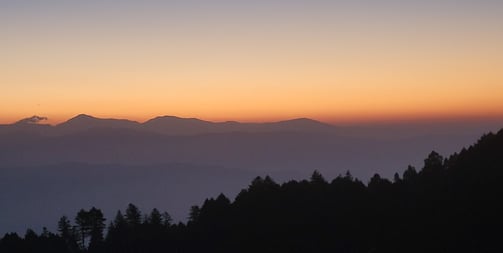

Now, imagine standing on one of these sacred hilltops at sunrise, with the first golden light touching the snow-capped peaks. No crowds, no noise—just you, the mountains, and the crisp, fresh air. This is what makes Sailung special. The energy here is different, something you feel rather than see. It’s a place to slow down, breathe, and just be.
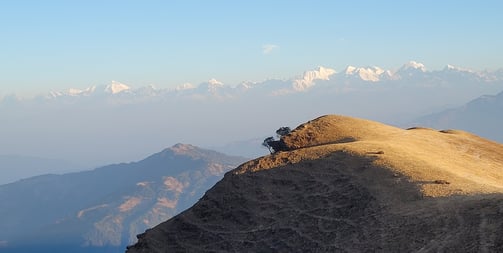

For many Nepalis, Sailung is a place of pilgrimage, peace, and deep connection to their heritage. It’s where people come not just to worship, but to detach from daily struggles and reconnect with something bigger than themselves.
Unlike Nepal’s crowded religious sites, Sailung offers a sense of solitude and purity, a reminder that spirituality doesn’t always need grand temples—it can be found in the silence of the hills, the whisper of the wind, and the endless horizon of the Himalayas.
So, if you’re looking to experience a side of Nepal that most travelers never see, a place where nature and spirituality exist in perfect balance, then Sailung is waiting for you.
Nature & Spirituality Blended Together
Best Seasons to Hike Shailung
Honestly, you can hike Sailung any time of the year, depending on which trail you take. We chose the shortest route, which is perfect for all seasons, and yes, it’s as convenient as it sounds. We hiked during winter, and the hills were covered in a beautiful golden-brown color, giving the place a kind of mystical, almost desert-like vibe. But we’ve already made a mental note to come back after the monsoon, just to see how the landscape transforms into lush, vibrant green.
However, one thing is for sure—you’ll need to adjust your clothing according to the season. Winter mornings? Expect it to be cold and windy with temperatures below zero. I won’t lie; my nose was freezing. But hey, the crisp air and clear skies made it worth every shiver. Summer, on the other hand, brings different challenges—think leeches and blazing sun. Not exactly the kind of company you want on a hike, so be prepared with leech protection and good sunscreen.
In short, Sailung is beautiful year-round, but each season has its own charm and challenges. As long as you’re dressed right and prepared, you’re in for a fantastic adventure. And if you’re like us, you’ll end up coming back again and again, just to see how this magical place keeps changing.
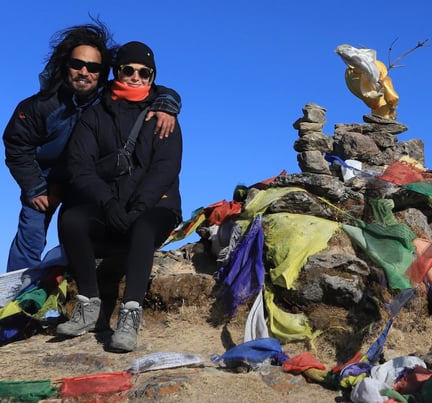

Shailung Hike Overview: Everything You Need to Know
Getting There & Staying the Night: Transportation and Accommodation Tips
Shailung short hike starts from the remote village of Kalapani, which translates to “black water.” Sounds mysterious, right? Well, the only mystery for me was figuring out how to get there. Luckily, these days it’s pretty straightforward—you can catch a local bus straight to the village. But, of course, there’s a catch: the bus leaves from Jadibuti bus station in Kathmandu at 7 am sharp, and it’s the only one for the day. So, if you’re the type who hits the snooze button one too many times, set an extra alarm (or three).
I’d highly recommend getting there by 6:30 am at the latest and reserving your tickets in advance, just to be safe. The ticket costs 675 NPR per person, and it takes a five-and-a-half-hour journey. There’s one quick stop for lunch at Mude Bazaar, but don’t get too comfy—this is a local bus, after all. The last two hours of the ride are classic Nepali style: bumpy, dusty, and enough to test your patience (and possibly your back). But hey, no adventure starts without a little discomfort, right?
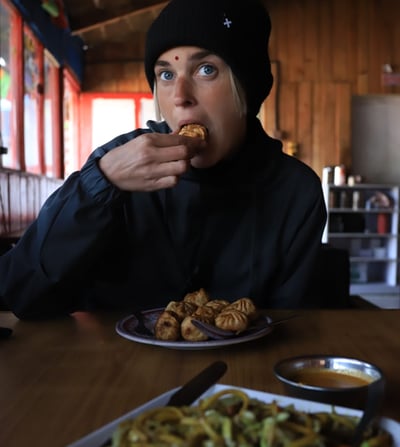

Once you finally arrive in Kalapani, don’t expect luxury. The village is pretty remote, and while they’re expanding to offer more accommodation options, choices are still limited. We stayed at “Sailung King Hotel,” where a room with an attached bathroom and hot water cost us 1500 NPR. Sounds decent? Well, let’s just say I wasn’t exactly thrilled with the condition of the room. It was freezing, and the windows had holes in them that let the cold air in, making it the perfect spot to test my tolerance to the cold.
For lunch and dinner, we decided to explore another nearby place, and honestly, it was the best decision. The food was delicious, high-quality, and the total cost for both meals was 1025 NPR. If you’re planning a trip, I’d suggest trying to stay at the “Sailung Inn Hotel” next time. I didn’t see the rooms, but they charge the same price, so it’s worth a shot.
Oh, and a little heads-up: most of the other hotels here are newly built but not well-maintained, so don’t go in with high expectations. Think of it as part of the authentic, rustic experience. After all, if you wanted luxury, you’d be booking a five-star in Kathmandu, not hiking in the middle of nowhere, right?
Starting Point & Route
If you’re wondering whether you can conquer Shailung’s peak on the same day you arrive in Kalapani, the answer is yes—but I wouldn’t recommend it. Why? Because after 1 pm, the clouds roll in like clockwork, and trust me, you don’t want to miss the Himalayan views. If you’re making the journey all the way here, do it right. Get an early night’s sleep, set that alarm (even if it hurts), and wake up before sunrise. There’s something magical about watching the world wake up—the hills slowly changing color, the first light hitting the Himalayan peaks, and the silence broken only by the whispers of the morning breeze.
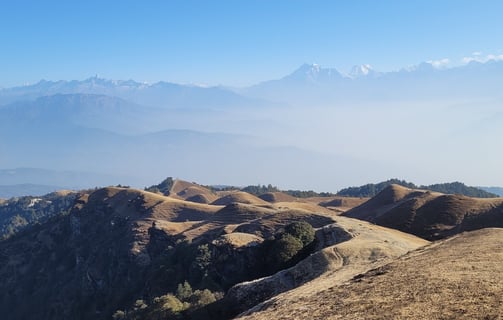

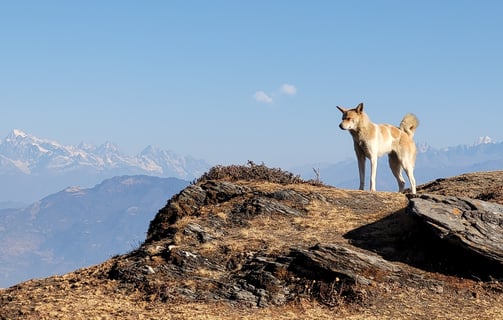

The trail is well-marked, so there’s no chance of getting lost and there is no entry fees. It took us about an hour and a half to reach the top, and it was nothing short of magical. Watching the sunrise paint the Himalayan peaks, the rolling hills, and even our faces was pure poetry. It’s an easy hike, so leave those trekking poles behind and enjoy the simplicity of the trail.
Once you reach the top, climb the watchtower for an epic 360-degree view of the Himalayan ranges and the beautifully layered hills. Fair warning: it’s windy up there. Like, “I-can’t-feel-my-face” kind of windy. But just when you think you can’t handle the cold any longer, you’ll spot a small café right next to the watchtower. And let me tell you, the ladies there have the kindest hearts. They’ll offer you a hot drink for free, and at that moment, it’ll taste better than anything you’ve ever had. But hey, generosity goes both ways. They don’t expect anything in return, but if you buy some chocolates or cookies from them, you’ll make their day.
Oh, and be prepared to make some four-legged friends. Local dogs love accompanying hikers to the top. These tireless little adventurers are in better shape than most of us, so bring some treats if you want to become their favorite human for the day. I mean, who doesn’t want a dog hiking buddy?
Continue the Journey: From Shailung to the Spiritual Heights of Kalinchowk
After finishing our Shailung hike, we were back at the hotel by 10 am—pretty decent for a day's work, right? But here’s where you have two options: you can either call it a day and head back to Kathmandu or keep the adventure rolling. We, of course, opted for the second choice and decided to visit another magical place—Kuri village and hike to Kalinchowk Temple. Another spiritual site, another boost of positive energy. So, we caught a bus from Kalapani to Mude Bazzar, and then waited an hour for the next bus to Charikot. Both buses costed us 900 NPR total.

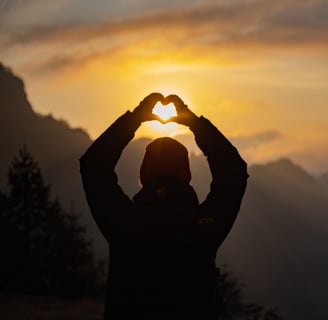
Initially, the plan was to stay overnight in Charikot and hike to Kuri Village in the morning, but we weren’t feeling the "roughing it" vibe on Valentine’s Day. So, we got lucky and found a shared jeep that would take us directly to Kuri village. The jeep cost us 1000 NPR for both of us, and it turned out to be the best decision we made all day.
I didn’t quite realize how intense the hike from Kuri village back would be until the next day. And let me tell you, hindsight is always 20/20. Definitely a smart move to enjoy a comfy ride straight to our hotel instead of testing our stamina on Valentine’s Day!
Kuri Village: A Sacred Stop Before Reaching Kalinchowk Temple
Kuri Village is like the secret doorway to one of Nepal’s hidden gems. It’s a peaceful little village nestled in the Dolakha district, surrounded by spectacular views of the mountains. However, don't be fooled into thinking you'll have it all to yourself—on weekends, especially Fridays, the place can get pretty crowded. Many Nepali people head there for the weekend, hiking up to Kalinchowk Temple on early Saturday morning and returning the same day, as Sunday is a working day here in Nepal. We actually happened to be there on a weekend, and let me tell you, it was already feeling a bit too crowded for my liking. But even with the hustle and bustle, the spiritual vibe of Kalinchowk Temple and the incredible mountain views make it worth the journey.
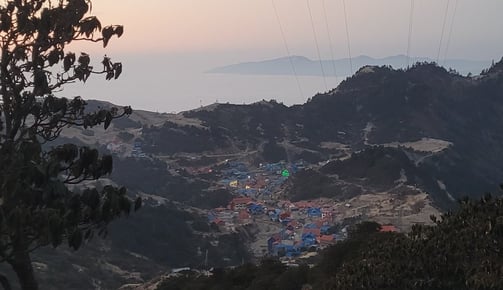

Kalinchowk Temple: A Sacred Site of Deep Significance and Powerful Energy
High above the clouds, nestled on a rugged hilltop in the Dolakha district, stands Kalinchowk Temple, a place of deep spiritual significance for the Nepali people. This ancient shrine is dedicated to Goddess Kali, a powerful deity known as the destroyer of evil and protector of the innocent. For centuries, pilgrims have made their way up to this sacred site, seeking blessings, protection, and spiritual cleansing. But beyond its religious importance, Kalinchowk Temple holds an undeniable energy that resonates differently with every visitor. I know this firsthand.
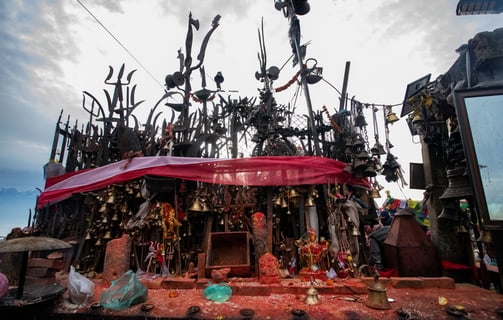

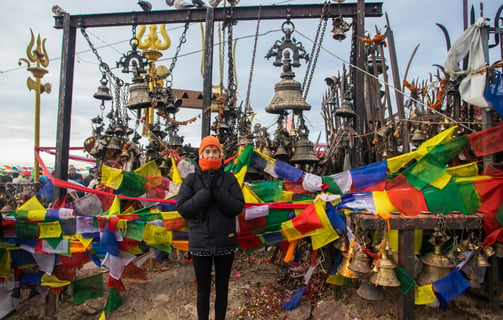

The Legend Behind Kalinchowk Temple
Every sacred place has a story, and Kalinchowk is no exception. According to legend, Goddess Kali appeared here to protect the villagers from evil spirits and grant them courage. She is worshipped as a fierce form of Durga, the goddess of power, and is believed to possess the strength to overcome all obstacles. The name itself, “Kalinchowk,” comes from ‘Kali’—the goddess—and ‘Chowk,’ meaning courtyard or open space, signifying her presence under the vast sky.
There’s also a belief that the temple is connected to the Panch Pokhari (Five Sacred Lakes). Pilgrims say that holy water from these lakes mysteriously flows up to Kalinchowk, symbolizing the goddess's divine energy. It’s this mystical connection that draws thousands of devotees to the temple, especially during Dashain and Tihar, the biggest festivals in Nepal, when people come to make offerings and seek blessings for prosperity and well-being.
Visiting Kalinchowk Temple isn’t just about the breathtaking Himalayan views; it’s about experiencing the spiritual energy that surrounds it. As you climb the steep path towards the temple, you’ll notice bells, prayer flags, and tridents (trishuls) placed along the way. These are offerings to the goddess, symbols of faith and protection.
At the temple, people perform puja (worship), ringing bells to announce their presence to the goddess. They offer flowers, fruits, and animal sacrifices (usually goats or chickens), a tradition deeply rooted in Hindu culture to appease Goddess Kali’s fierce form. It’s a place where devotion is felt in the air, where prayers are whispered to the wind that dances around the ancient shrine.
I watched as families gathered, eyes closed, hands folded, chanting mantras with complete faith. It was powerful, even overwhelming. But that wasn’t the only overwhelming experience I had.
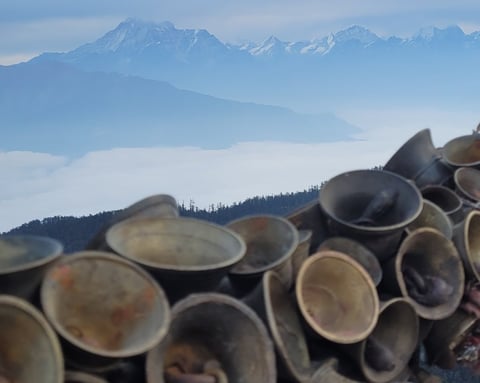

A Mysterious Encounter with Energy
We reached the temple early in the morning, hoping to beat the crowds, but even then, it was buzzing with people. It’s important to know that Kalinchowk gets incredibly crowded during weekends and festivals. I thought I was prepared for the crowd, but the energy there was unlike anything I’d ever felt before.
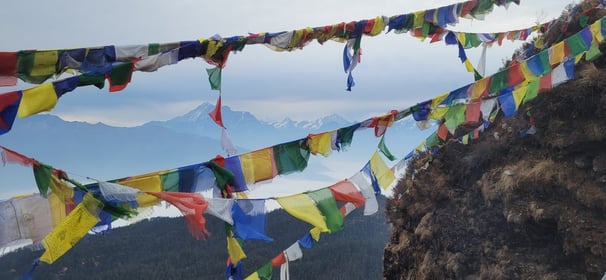

I started feeling a massive headache, shivering, and this strange heaviness. It wasn’t just the altitude, even though the temple sits at 3,842 meters above sea level. At first, we thought it could be altitude sickness, but the symptoms didn’t go away even after we descended. The headache lingered for two days, something I’ve never experienced before, not even during other high-altitude treks. It felt as if the energy of the place had a hold on me.
I’m not someone who easily gives in to mystical explanations, but this experience left me questioning.
Was it the spiritual power of Goddess Kali? The overwhelming energy of the crowds? Or just my body reacting to the thin air? Who knows? It truly depends on what you believe in. But one thing is certain—Kalinchowk Temple is more than just a religious site; it’s a place of intense energy that can touch you deeply.
Kalinchowk Hike Overview: Everything You Need to Know
Getting There & Staying the Night: Transportation and Accommodation Tips
First things first: there is no direct bus from Kathmandu to Kuri Village. You can follow the route we took, or choose from a few other options, depending on your adventure level and comfort preference. The most common (and budget-friendly) route is to take a local bus from Kathmandu to Charikot. Once you get to Charikot, you’ll need to hire a jeep to take you up to Kuri Village. This is because the road from Charikot to Kuri is steep and winding—definitely not for the faint-hearted or those prone to motion sickness. Also, keep in mind that during weekends or festival seasons, the jeeps get fully packed, so it’s better to arrange it in advance or prepare to wait. We reached Hotel Peace & Happy (phone no.: 984-0400500), and they arranged us shared jeep on the same day.
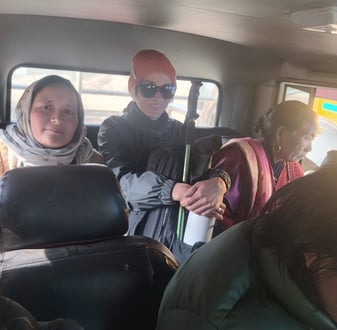

Feeling adventurous? You can hike from Charikot to Kuri Village, but brace yourself—it’s a long and challenging trek that takes around 7 to 8 hours. The trail is steep and rugged, and you’ll be gaining quite a bit of altitude. I won’t sugarcoat it—it’s tough. But if you’re up for the challenge and want to soak in the breathtaking scenery, this could be your path to adventure. Just make sure you’re well-prepared with good hiking shoes, plenty of water, and a strong willpower.
If you want to make the journey easier, you can book a private van straight from Kathmandu to Kuri Village. This is the most comfortable and convenient option, especially if you’re traveling in a group. It’ll cost more than the local bus, but sometimes comfort is worth the extra cash, especially when you’re gearing up for a hike the next day.
Kuri Village is a charming little place nestled at the foot of Kalinchowk Temple. Despite its remote location, it offers a surprising variety of accommodation options, ranging from simple guest houses to luxury hotels.
We decided to stay at Waling Fulbari Guest House, and honestly, it was the best choice. We paid 1000 NPR for a room without an attached bathroom for one night. It was simple but clean, and the warm hospitality made up for the lack of fancy amenities.
Now, let’s talk about the food. As soon as I found out that the cook was the mother in this family-run guest house, I knew we were in for a treat. There’s just something heartwarming about home-cooked meals, especially when you’re high up in the mountains. We paid 2050 NPR for lunch, dinner, and hot drinks, and every bite was worth it. The food was fresh, delicious, and served with love—a perfect way to refuel after a day of traveling and hiking.
My honest suggestion? Start as early as possible. We kicked off our hike at 6 am, and there were already plenty of locals on the trail. And trust me, you want to get going before sunrise. The exact timing depends on the month you’re there, but catching that sunrise is worth every early-morning yawn. It was absolutely spectacular and magical. We stopped more times than I can count, just to breathe in the moment and soak in the view.

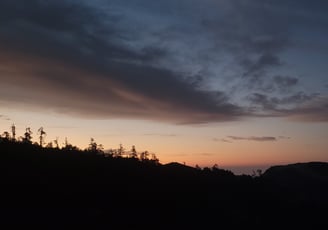
The hike itself isn’t too difficult, easy navigate, but it is steep and has a lot of stairs. We managed to reach the temple in about an hour. If hiking isn’t your thing, there’s also a cable car. But here’s the catch—they only sell round-trip tickets. It costs 1300 NPR for foreigners or 600 NPR for Nepali citizens. There’s no entry fee to visit Kalinchowk Temple, which is nice.

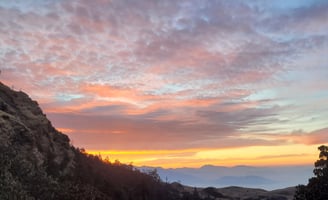
After doing our prayers and snapping many pictures, we headed back to our hotel. We decided to hike down to Charikot and catch a bus to Kathmandu from there. If hiking down doesn’t sound appealing, you can look for a shared van straight to Kathmandu (around 1000 NPR per person) or take the same jeep back. But since we’re hikers at heart, we chose to hike down. We heard there was a trail with many shortcuts, and we were up for the adventure.
Well, let me tell you—it wasn’t as easy as we thought. It’s all downhill, with a few sections of “Nepali flat” (which means it’s still not really flat). And don’t forget, I was dealing with a massive headache the whole way down. We reached Deurali village in about 3 hours and started asking the locals about getting to Charikot. The best option? Keep walking down to the next village, MakaiBari.
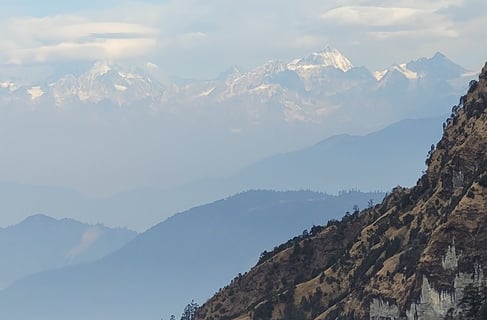

By 2 pm, we caught a bus, and by 8 pm, we were back in Kathmandu. The bus tickets cost us 1200 NPR, and we ended up walking almost 21 km that day. Would we descend the same way next time? Definitely. It was challenging, but the adventure made it worth it.
Final Words
Looking back at this incredible journey to Sailung and Kalinchowk, my heart is full of gratitude. These places hold a special kind of magic that can’t be put into words. From breathtaking sunrises to the powerful energy at Kalinchowk Temple, every moment felt deeply meaningful. And yes, even the challenging parts were worth it.
The beauty of this trek is that you don’t need any permits or a guide to explore these trails. But if I’m being honest, having a guide who knows the stories, the history, and the heart of Nepal makes the experience so much richer. They bring the land to life in a way you just can’t get on your own.
We’ll definitely be back after the monsoon season—I feel like there’s so much more to discover. If you’re planning your own adventure or need some advice, feel free to reach out. I’m always happy to help fellow travelers find the beauty in this incredible country.
Until next time, keep exploring and embracing the journey!
पहाडबाट, सान्द्रा
From the mountains, Sandra 🙏✨


